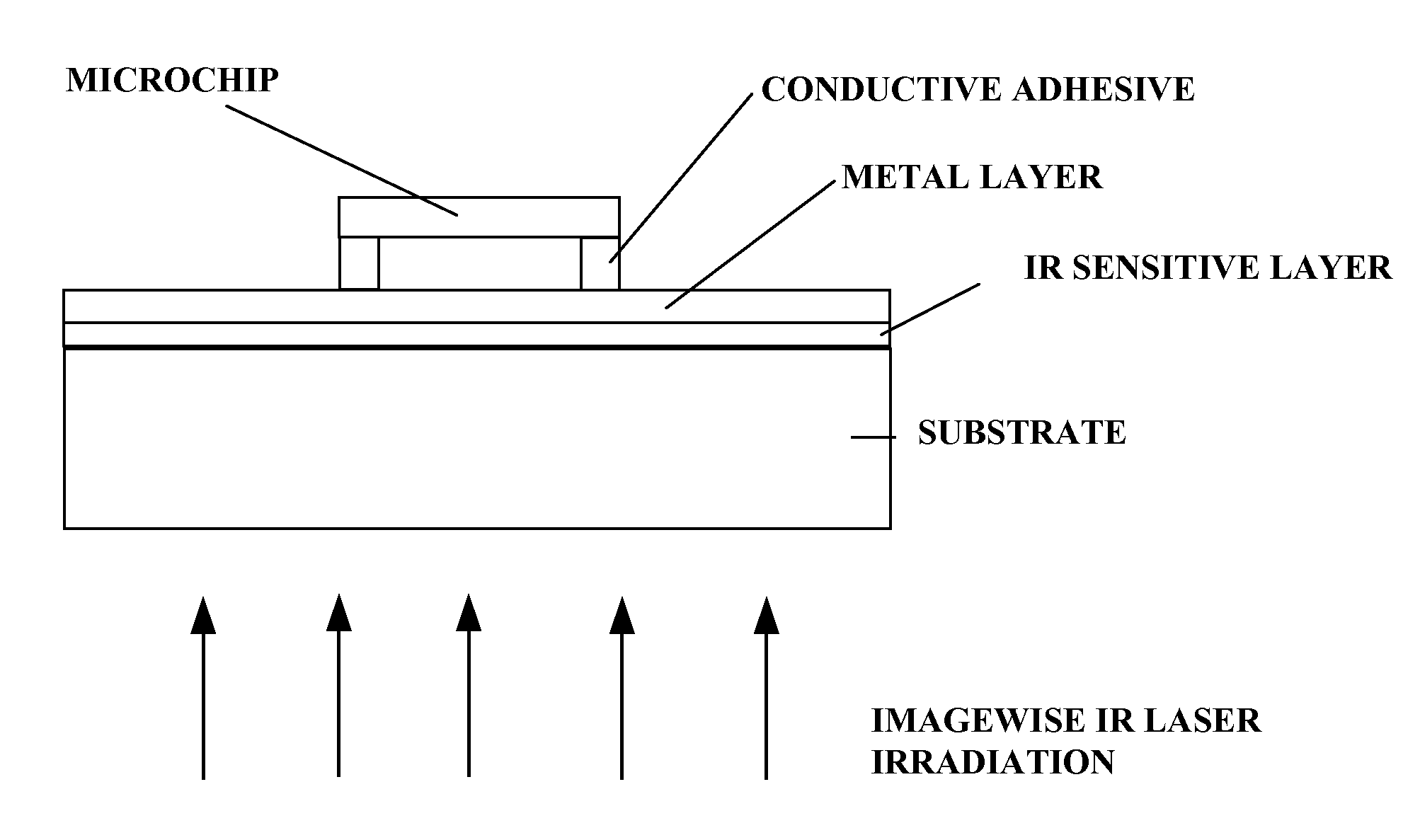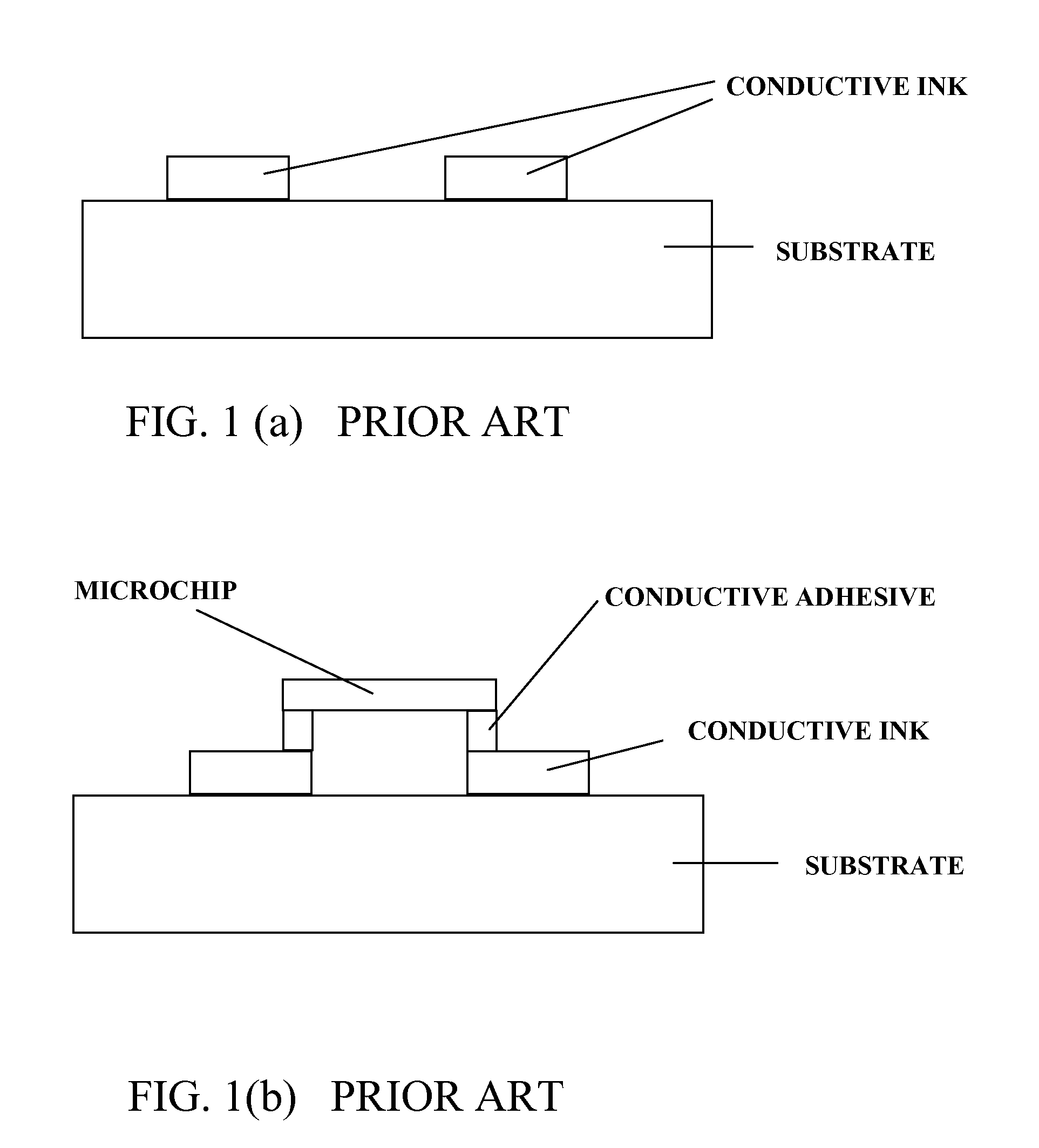Its use in
inventory control, security, etc. for packaged goods has serious financial ramifications.
However, there are several roadblocks to the commercial use of RFID technology.
A key factor is the inability to
mass produce tags with required functionalities in a simple, reliable, and consistent manner, and producing them cost effectively, for making widespread applications feasible.
Unfortunately, the currently available methods of tag manufacturing are not capable of meeting these requirements and therefore, the industry and the market, are at a stand still.
The cost of the antennae has been identified to be one of the key limiting variables and therefore, an intense effort is being made to overcome this problem.
The process is old, well understood and broadly practiced, however, wasteful, environmentally harmful, expensive, and therefore it is not able to take the industry to the next level.
However, none has been successful as a solution.
However, most of the
solid state electronic circuitry is rigid and therefore, not suitable for use on packaging items, as most such items are flexible materials.
Therefore, a tremendous amount of effort is being used developing so called “
printed electronics.” The goal of
printed electronics is to print the required elements of an electrical circuitry onto the flexible substrate itself.
However, this process poses serious environmental and health and safety hazards.
This limits the number of substrates that can be used to print on, since only expensive substrates with high
softening temperature may be used to avoid any deformation.
High temperature requirement also seriously reduces the overall productivity of the process.
Moreover, due to
high loading of silver
powder requirement, the ink formulations must contain extraneous additives, including volatile organic compounds (VOC), to produce inks in a printable fashion.
Although this process avoids any high temperature
processing, it is a slow and wet process, with their inherent disadvantages.
While this approach promises to yield silver free, less expensive antennae, the productivity of such process is very low since
UV laser irradiation has a limited
energy level for ablating thicker metal
layers and electrodeposition process is extremely slow and requires utilization of
wet chemistry.
Lack of connection would further reduce the yield of the process and above all, reliability of the transponders itself.
Overall, the limitations of all the current and available approaches make the RFID antennae and transponders produced expensive, and limit their viability as commercially successful processes to satisfy projected industry needs for billions of inexpensive RFID transponders, for all types of applications including tagging of individual items.
Similarly, commercial manufacturing of
microwave susceptors or sensors also face similar limitations.
However, this approach is complex.
In order to achieve a high enough
conductivity at printed film thickness, mainly silver is used as metal, which is expensive.
The metal must also be in
powder form with particle size
ranging from
micrometer to nanometer with their associated
processing cost, further increasing the material cost.
The substrate must be able to withstand high bake temperature ˜130° C. without
thermal distortion, and therefore can primarily be expensive polyesters with high
glass transition temperature (Tg).
High web surface temperature requirement also slows down the overall printing process, increasing cost.
Therefore, materials are selected which would volatilize during the baking step, which in turn create undesired environmental (VOC) and health & safety issues.
In addition, despite the high heating step, the metal particles in the printed antenna simply do not attain their original metallic
crystal structure and therefore results in printed antennae with somewhat reduced metal
conductivity compared to their original value.
Any misalignment would increase waste factor and above all would increase unreliability of the
system, increasing potential risks and security breaches in several sensitive
application areas.
However, even with this approach there is at least 1-3% unreliability factor, which for
mass adoption poses a great
disadvantage.
The overall complexity, unreliability and economics of the current “printed antenna” process simply does not lend itself to be a solution to preventing the RFID market from achieving intended commercial success and there is a serious need for a new fabrication method for RFID antenna.
 Login to View More
Login to View More 


